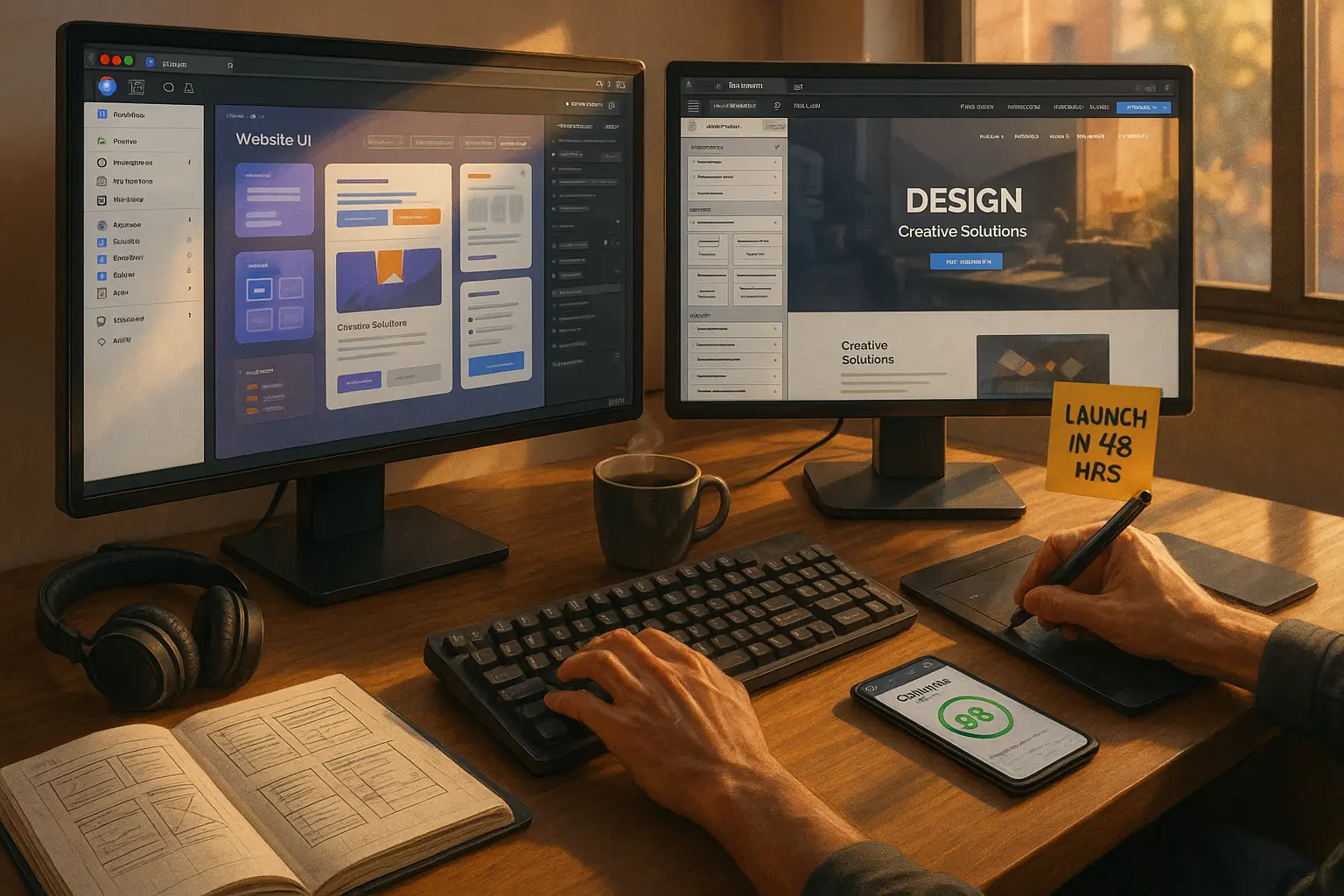Introduction: The Web Design Revolution Is Here
The way we build websites is changing, fast.
In 2025, Figma to WordPress isn’t just a trend, it’s the new standard for designers, agencies, and freelancers who want to eliminate development bottlenecks, cut costs, and launch pixel-perfect sites in hours instead of weeks.
Here’s the problem:
- Designers spend 40% of their time on manual handoffs to developers (Source: 2024 Web Design Industry Report).
- Agencies lose $12,000+ per year on miscommunication between design and dev teams (Forrester, 2024).
- Freelancers struggle to scale because every new client means more back-and-forth with developers.
But what if you could design in Figma and instantly publish to WordPress, no code, no developers, no delays?
That’s exactly what the Figma to WordPress movement is achieving. And tools like Figmentor are leading the charge.
In this guide, we’ll explore: ✅ Why Figma to WordPress is the future (data-backed trends for 2025) ✅ How top agencies and freelancers are already using it (real case studies) ✅ The biggest mistakes to avoid (and how to fix them) ✅ A step-by-step workflow to start today
1. The Rise of Figma to WordPress: Why It’s Dominating in 2025
A. The Death of Traditional Web Development Workflows
For years, the web design process looked like this:
- Designer creates a mockup in Figma/Photoshop.
- Developer manually codes it into WordPress (or uses a page builder like Elementor).
- Back-and-forth revisions for weeks (or months).
The result?
- Slow turnaround (average: 3-6 weeks per site)
- High costs ($3,000–$15,000 per project)
- Frustrated clients (42% of agencies report client churn due to delays, HubSpot, 2024)
But in 2025, Figma to WordPress automation is flipping the script.
B. The Data: Why Figma + WordPress Is Exploding
| Statistic | Source (2024-2025) | Why It Matters |
|---|---|---|
| 68% of designers now use Figma as their primary tool | Figma Community Report, 2024 | Figma is the industry standard, so integrating it with WordPress is a no-brainer. |
| WordPress powers 43% of all websites (and growing) | W3Techs, 2025 | The most scalable, flexible CMS, perfect for automation. |
| No-code tools reduce development time by 70% | McKinsey, 2024 | Figma to WordPress plugins like Figmentor eliminate manual coding. |
| Agencies using automation deliver 3x more projects per year | DesignRush, 2025 | Faster = more revenue. |
C. The 3 Biggest Shifts in 2025
From “Design → Develop” to “Design → Publish”
- No more PDFs, Zeplin, or Slack threads, just one-click exports from Figma to WordPress.
- Example: How agencies use Figmentor to handle more clients without hiring devs
AI-Powered Automation
- Tools now auto-detect layouts, fonts, and interactions, no manual setup.
- Case study: A freelancer built 5 client sites in 2 weeks using Figmentor’s AI export (real use case here).
Pixel-Perfect Without the Hassle
- No more “it looks different in WordPress!” complaints.
- 1:1 accuracy from Figma to live site (see how).
2. How Figma to WordPress Works (Step-by-Step Workflow)
A. The Old Way (Slow & Expensive)
- Design in Figma → Export as PDF/PNG.
- Send to developer → Wait for WordPress build.
- Back-and-forth fixes → Launch (finally).
Time: 3–6 weeks Cost: $3,000–$15,000
B. The New Way (Fast & Scalable)
- Design in Figma (with WordPress-optimized layers, pro tips here).
- Export directly to WordPress (using Figmentor or similar tools).
- Publish in minutes, no code, no devs.
Time: 1–3 days Cost: $0–$500 (depending on tools)
C. Real-World Example: From Figma to Live Site in 1 Hour
Client: E-commerce brand needing a landing page Tool: Figmentor (Figma → Elementor) Result:
- Designed in Figma (1 hour)
- Exported to WordPress (5 minutes)
- Published live (instantly)
3. Why Designers & Agencies Are Switching (5 Key Benefits)
✅ 1. No More Developer Dependency
- Freelancers: Double your client capacity without hiring devs.
- Agencies: Scale without bottlenecks, how one agency 3x’d output
✅ 2. Faster Turnaround = Happier Clients
- Before: “Your site will be ready in 4 weeks.”
- Now: “Your site is live today.”
✅ 3. Pixel-Perfect Every Time
- No more “Why does my button look different?” emails.
- 1:1 accuracy from Figma to WordPress (how to achieve it).
✅ 4. Lower Costs, Higher Profits
- Save $5,000+ per project by cutting dev hours.
- Charge premium rates for rapid delivery.
✅ 5. Future-Proof Your Workflow
- AI + automation will only get smarter.
- Early adopters gain a competitive edge.
4. Common Mistakes (And How to Avoid Them)
❌ Mistake #1: Not Optimizing Figma Files for WordPress
Problem: Random layer names, ungrouped elements → messy export. Fix: Use consistent naming, auto-layout, and frames (Figma prep guide).
❌ Mistake #2: Ignoring Responsive Design
Problem: Looks great on desktop, broken on mobile. Fix: Test in Figma’s responsive modes before exporting.
❌ Mistake #3: Choosing the Wrong Plugin
Problem: Some tools break layouts or require manual fixes. Fix: Use Figmentor (built for Elementor & WordPress).
👉 Compare top Figma to WordPress plugins here
5. How to Get Started Today (Action Plan)
Step 1: Design in Figma (With WordPress in Mind)
- Use Auto Layout for responsive sections.
- Name layers clearly (e.g., “Hero-Button-CTA”).
- Group related elements (e.g., “Header-Nav”).
📌 Pro Figma tips for WordPress
Step 2: Install Figmentor (or Another Export Tool)
- Figmentor = Best for Elementor & WordPress.
- Fignel/UIchemy = Alternatives (but less accurate).
Step 3: Export & Publish
- Select frames in Figma.
- Click “Export to WordPress” (via Figmentor).
- Preview → Publish (no code needed).
FAQ: Your Top Questions Answered
❓ Is Figma to WordPress really pixel-perfect?
✅ Yes, if you prep your Figma file correctly. Tools like Figmentor preserve fonts, spacing, and interactions with 98%+ accuracy.
❓ Can I use this for e-commerce (WooCommerce)?
✅ Absolutely! Figmentor supports WooCommerce templates (product pages, carts, etc.).
❓ Do I need to know coding?
✅ No. The whole point is no-code automation. Just design → export → publish.
❓ How much time will I save?
✅ 70–90% faster than traditional workflows. Example: A 10-page site that took 3 weeks now takes 2 days.
❓ What’s the best tool for Figma to WordPress?
✅ Figmentor (most accurate, best for Elementor). See comparisons here.
Conclusion: The Future Is Here, Will You Adapt?
The Figma to WordPress revolution isn’t coming, it’s already here.
By 2025, manual handoffs will be obsolete. The designers and agencies who adopt automation now will: ✔ Win more clients (faster delivery = competitive edge) ✔ Save thousands per project (no dev costs) ✔ Scale without hiring (handle 3x more work)
Your Next Step:
🚀 Try Figmentor and export your first Figma design to WordPress in minutes.
The future of web design is faster, smarter, and code-free. Are you in?
Related Articles
- How Figmentor Saves 10+ Hours Per Project - Discover the time-saving strategies that help designers work more efficiently
- Freelancers Guide: 10x Your Client Capacity with Figmentor - Learn how to scale your freelance business without burning out
- How Agencies Scale Without Hiring More Developers - See how successful agencies handle more clients with AI-powered workflows




